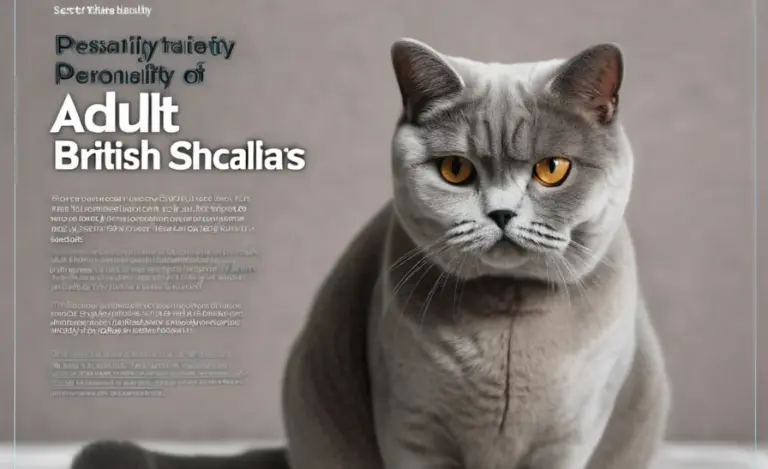Personality Guide for First-Time British Shorthair Owners: Easy!
Quick Summary: British Shorthairs are known for their calm, affectionate nature, making them wonderful companions. They’re independent cats, not overly demanding of attention, but they enjoy interactive play and gentle cuddles. Understanding their personality helps create a happy home. British Shorthairs adapt well to indoor living and get along with children and other pets when properly introduced.
Bringing a British Shorthair into your home is an exciting time! These charming cats are famous for their round faces and plush coats, but it’s their personality that truly wins hearts. Are you wondering if a British Shorthair is right for you? Or perhaps you’ve just welcomed one into your family and want to understand them better? Many first-time owners find themselves curious about what makes these cats tick.
Don’t worry, you’re not alone! Understanding your British Shorthair’s personality is the first step to building a loving and lasting bond. This guide will walk you through everything you need to know, from their typical temperament to how to best interact with them. Let’s explore the delightful world of the British Shorthair and discover how to create a purr-fectly harmonious home together.
Understanding the British Shorthair Temperament

The British Shorthair is known for its generally laid-back and adaptable nature. However, like all cats, individual personalities can vary. Let’s explore the core traits that define this breed:
Affectionate but Independent
British Shorthairs are affectionate cats, but they aren’t usually “lap cats.” They enjoy being near their humans and will often follow you from room to room. Instead of constant cuddles, they show their love with gentle head boops, slow blinks, and by simply being present in your space. They are more independent than some breeds and are perfectly happy spending time alone, making them a good choice for people who work during the day. According to the RSPCA, understanding a cat’s need for independence is crucial for their well-being.
Calm and Gentle
Their calm demeanor makes them excellent companions for families with children and other pets. They are generally tolerant and patient, but it’s still important to teach children how to interact with them respectfully. Loud noises or sudden movements can startle them, so a calm environment is best. As TICA notes, early socialization plays a key role in developing a well-adjusted temperament.
Playful but Not Hyperactive
While they aren’t as energetic as some other breeds, British Shorthairs still enjoy playtime. They appreciate interactive games with toys like feather wands or laser pointers. Providing them with scratching posts and puzzle toys helps keep them mentally stimulated and physically fit. A short play session each day is usually enough to keep them happy and healthy.
Not Excessively Vocal
If you’re looking for a quiet cat, the British Shorthair might be the perfect choice. They are not known for being overly vocal. They will meow to greet you or to let you know they’re hungry, but they aren’t likely to engage in long conversations. This makes them a good fit for apartment living or for people who prefer a quieter home.
Creating the Ideal Environment for Your British Shorthair
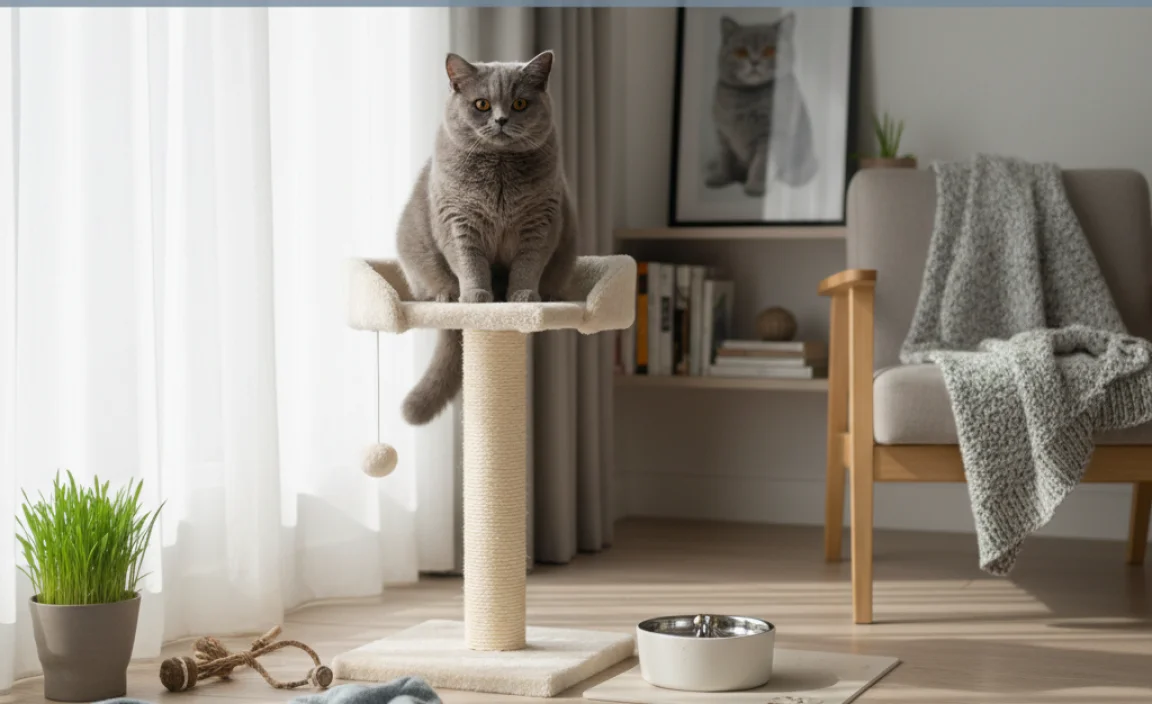
To ensure your British Shorthair thrives, it’s essential to create an environment that caters to their needs and personality. Here’s how:
Safe and Comfortable Indoor Space
British Shorthairs are best suited for indoor living. This protects them from outdoor dangers such as cars, predators, and diseases. Provide them with a comfortable bed in a quiet area where they can retreat to when they need some alone time. A window perch allows them to observe the outside world, which can be very entertaining for them.
Scratching Posts and Toys
Scratching is a natural behavior for cats, so providing them with scratching posts is essential. This prevents them from scratching your furniture. Offer a variety of toys to keep them mentally stimulated. Rotate the toys regularly to keep them interested. Puzzle toys that dispense treats are a great way to engage their minds.
Litter Box Placement and Hygiene
Place the litter box in a quiet, accessible location away from their food and water. Keep the litter box clean by scooping it daily and changing the litter regularly. British Shorthairs are known for being fastidious, so a clean litter box is a must. The Cornell Feline Health Center emphasizes the importance of litter box hygiene for a cat’s overall health and well-being.
Food and Water
Provide fresh food and water at all times. Choose a high-quality cat food that is appropriate for their age and activity level. British Shorthairs are prone to weight gain, so it’s important to monitor their food intake and prevent overfeeding. Consult with your veterinarian about the best diet for your cat.
Bonding with Your British Shorthair
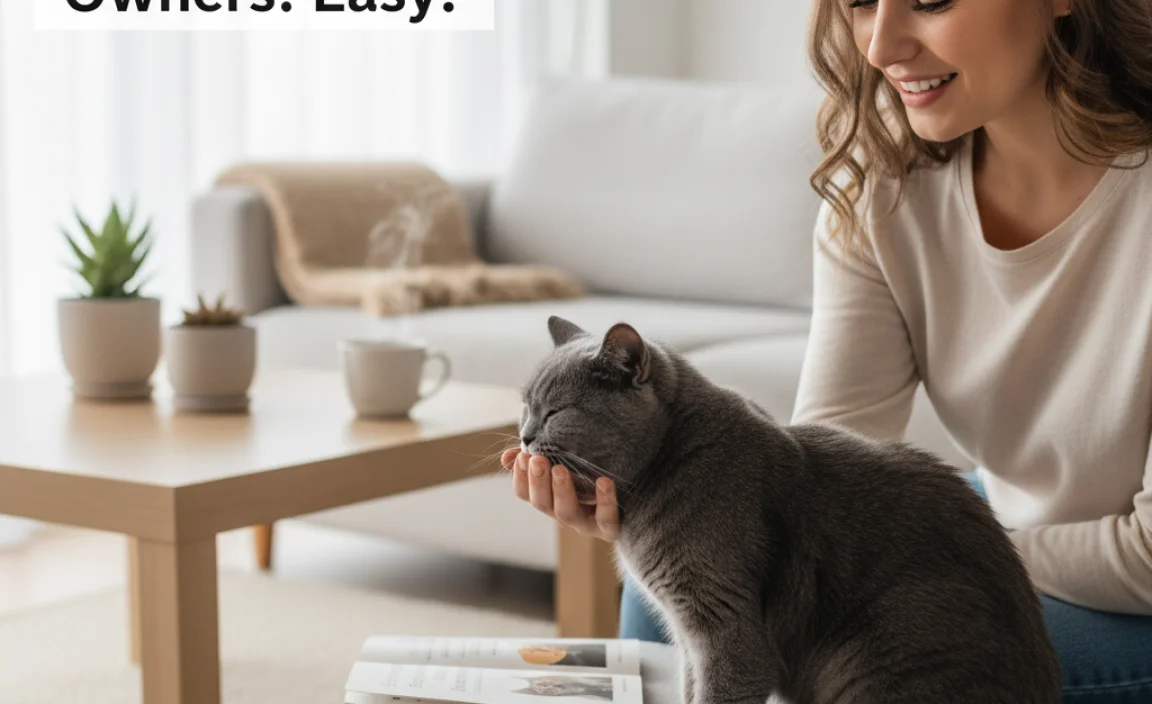
Building a strong bond with your British Shorthair takes time and patience. Here are some tips to help you connect with your new feline friend:
Gentle Approach and Patience
When you first bring your British Shorthair home, give them time to adjust to their new surroundings. Avoid overwhelming them with attention. Let them explore at their own pace. Speak to them in a calm, soothing voice. Offer them treats and toys to help them associate you with positive experiences.
Interactive Play Sessions
Engage in regular interactive play sessions. Use toys like feather wands or laser pointers to stimulate their natural hunting instincts. This is a great way to bond with your cat and provide them with exercise. Keep the play sessions short and sweet to avoid overstimulating them.
Respect Their Boundaries
British Shorthairs appreciate their personal space. Pay attention to their body language. If they seem uncomfortable or try to move away, respect their boundaries. Avoid forcing them to cuddle or be held if they don’t want to. Let them come to you for affection.
Positive Reinforcement
Use positive reinforcement to encourage good behavior. Reward them with treats, praise, or petting when they do something you like. Avoid punishment, as this can damage your relationship and create fear. Purina highlights the effectiveness of positive reinforcement in cat training.
Common British Shorthair Behaviors and How to Address Them
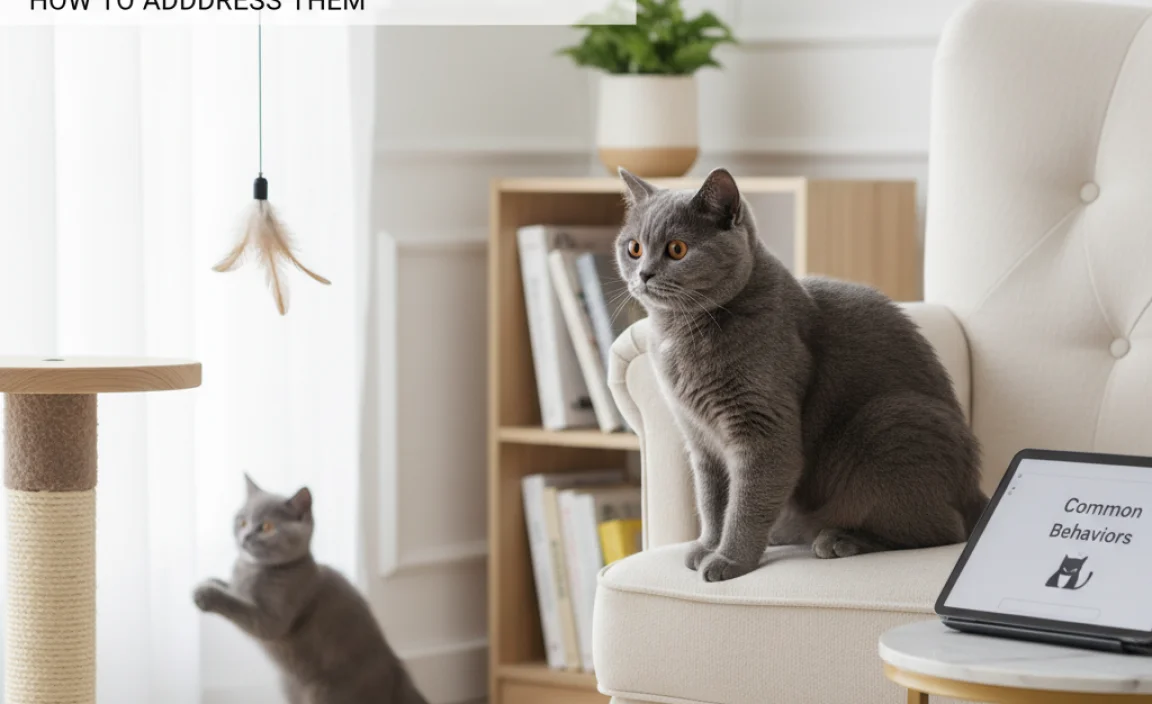
While British Shorthairs are generally well-behaved, they may exhibit some common behaviors that new owners should be aware of. Here’s how to address them:
Scratching Furniture
If your British Shorthair is scratching your furniture, provide them with plenty of scratching posts. Place the scratching posts near the areas they are scratching. You can also use catnip to attract them to the scratching posts. If they continue to scratch the furniture, try covering it with a material they don’t like, such as plastic or aluminum foil.
Overeating
British Shorthairs are prone to overeating, which can lead to obesity. Monitor their food intake and prevent overfeeding. Feed them measured portions of food at regular intervals. Avoid leaving food out all day. If your cat is overweight, consult with your veterinarian about a weight loss plan.
Fearfulness
Some British Shorthairs may be fearful or anxious, especially in new situations. Provide them with a safe and quiet space where they can retreat to when they feel overwhelmed. Use pheromone diffusers to help calm their anxiety. Avoid exposing them to stressful situations if possible.
Aggression
Aggression is not typical of the British Shorthair breed. If your cat is exhibiting aggressive behavior, consult with your veterinarian or a certified cat behaviorist. Aggression can be caused by medical issues, pain, or fear. It’s important to identify the underlying cause and address it appropriately.
Health Considerations for British Shorthairs
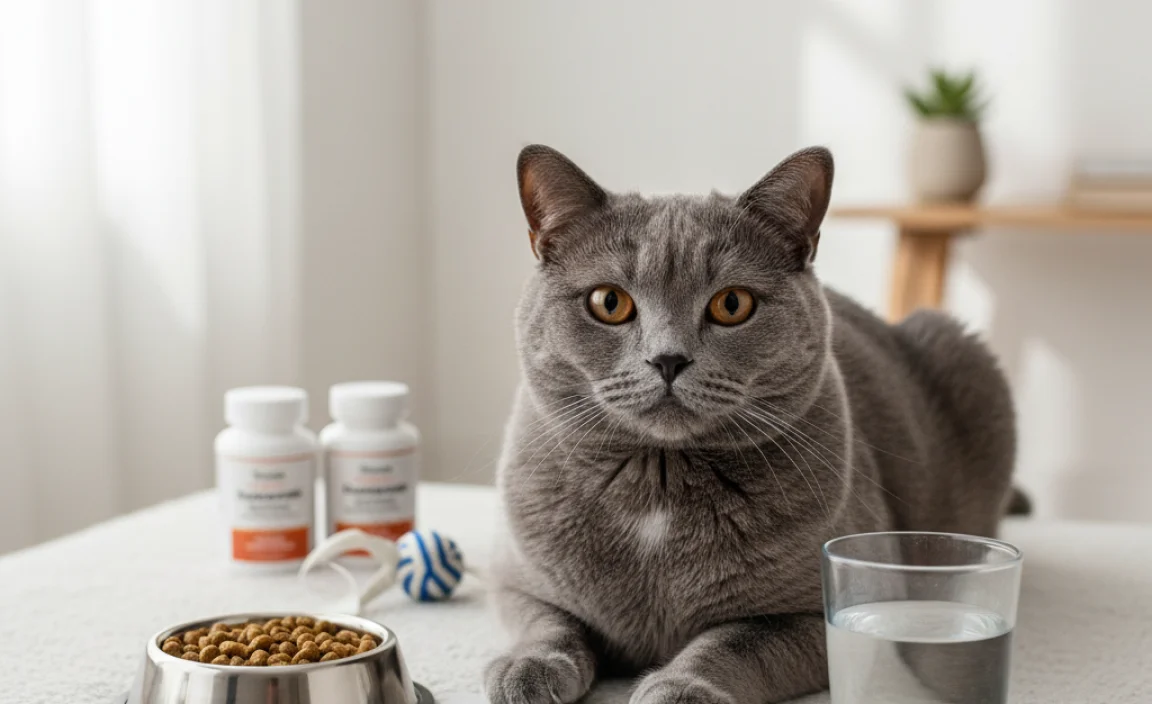
While generally healthy, British Shorthairs are prone to certain health conditions. Being aware of these potential issues can help you provide the best possible care for your cat.
Hypertrophic Cardiomyopathy (HCM)
HCM is a common heart condition in cats, including British Shorthairs. It causes the heart muscle to thicken, making it difficult for the heart to pump blood effectively. Symptoms can include difficulty breathing, lethargy, and fainting. Regular veterinary checkups and screening tests can help detect HCM early.
Polycystic Kidney Disease (PKD)
PKD is a genetic condition that causes cysts to form on the kidneys. These cysts can eventually lead to kidney failure. Symptoms can include increased thirst and urination, weight loss, and vomiting. Genetic testing can help identify cats that are at risk for PKD.
Obesity
British Shorthairs are prone to weight gain, which can lead to a variety of health problems, including diabetes, arthritis, and heart disease. Monitor your cat’s food intake and provide them with plenty of exercise to prevent obesity. Consult with your veterinarian about the best diet for your cat.
Dental Disease
Dental disease is common in cats of all breeds. Regular dental cleanings and home dental care can help prevent dental problems. Brush your cat’s teeth regularly and provide them with dental treats and toys. The American Veterinary Medical Association recommends regular dental checkups for pets.
Grooming Your British Shorthair
The British Shorthair’s plush coat requires regular grooming to prevent matting and shedding. Here’s what you need to know:
Brushing Frequency
Brush your British Shorthair several times a week to remove loose hair and prevent mats. During shedding season (spring and fall), you may need to brush them daily. Use a slicker brush or a metal comb to remove loose hair.
Bathing
British Shorthairs don’t typically need frequent baths. Bathe them only when they are dirty or have a strong odor. Use a cat-specific shampoo and rinse thoroughly. Be sure to dry them completely to prevent them from getting chilled.
Nail Trimming
Trim your cat’s nails every few weeks to prevent them from becoming too long and sharp. Use cat nail clippers and be careful not to cut the quick (the pink part of the nail). If you’re not comfortable trimming your cat’s nails yourself, you can have your veterinarian or a groomer do it for you.
Ear Cleaning
Check your cat’s ears regularly for dirt and wax buildup. Clean their ears with a cotton ball and a cat-specific ear cleaning solution. Avoid using cotton swabs, as they can push debris further into the ear canal. If you notice any signs of infection, such as redness, swelling, or discharge, consult with your veterinarian.
British Shorthair Personality: A Quick Reference Table
Here’s a handy table summarizing the key aspects of the British Shorthair personality:
| Trait | Description |
|---|---|
| Affectionate | Enjoys being near humans, shows affection with head boops and slow blinks. |
| Independent | Happy to spend time alone, not overly demanding of attention. |
| Calm | Laid-back and gentle, adaptable to different environments. |
| Playful | Enjoys interactive play sessions with toys. |
| Quiet | Not excessively vocal, meows mostly for greetings or needs. |
| Intelligent | Can be trained with positive reinforcement, enjoys puzzle toys. |
| Social | Gets along well with children and other pets when properly introduced. |
British Shorthair: Pros and Cons
Thinking about welcoming a British Shorthair into your family? Here’s a balanced look at the breed’s pros and cons:
- Pros:
- Calm and affectionate temperament
- Relatively low-maintenance grooming
- Adaptable to indoor living
- Gets along well with children and other pets
- Not excessively vocal
- Cons:
- Prone to certain health conditions like HCM and PKD
- Tendency to overeat and gain weight
- Can be independent and not always cuddly
- May require patience during initial adjustment period
- Prone to dental disease
British Shorthair Lifespan and Care
The average lifespan of a British Shorthair is between 12 and 17 years. Providing proper care, including a healthy diet, regular exercise, and veterinary checkups, can help your cat live a long and happy life. Here are some key considerations:
- Nutrition: Feed your British Shorthair a high-quality diet that is appropriate for their age and activity level. Avoid overfeeding and provide fresh water at all times.
- Exercise: Provide your cat with plenty of opportunities for exercise. Engage in interactive play sessions and provide them with toys to keep them mentally stimulated.
- Veterinary Care: Schedule regular veterinary checkups to monitor your cat’s health and detect any potential problems early. Follow your veterinarian’s recommendations for vaccinations and parasite prevention.
- Grooming: Brush your cat’s coat regularly to prevent matting and shedding. Trim their nails every few weeks and clean their ears as needed.
- Love and Attention: Spend time with your cat and provide them with love and attention. This will help them feel secure and bonded to you.
FAQ About British Shorthair Personality
Here are some frequently asked questions about the British Shorthair personality:
- Are British Shorthairs good for first-time owners?
- Yes, British Shorthairs are generally a good choice for first-time owners due to their calm and adaptable nature. They are relatively low-maintenance and not overly demanding of attention.
- Do British Shorthairs like to be held?
- While affectionate, British Shorthairs aren’t typically “lap cats.” They prefer to be near their owners rather than constantly held. Respect their boundaries and let them come to you for affection.
- Are British Shorthairs good with children?
- Yes, British Shorthairs are generally good with children, but it’s important to teach children how to interact with them respectfully. A calm environment is best, as loud noises or sudden movements can startle them.
- Are British Shorthairs intelligent?
- Yes, British Shorthairs are intelligent cats. They can be trained with positive reinforcement and enjoy puzzle toys that challenge their minds.
- Do British Shorthairs get lonely?
- While they are independent, British Shorthairs still need companionship. Provide them with plenty of attention and playtime to prevent them from getting lonely. If you work long hours, consider getting a second cat to keep them company.
- How do I know if my British Shorthair is happy?
- A happy British Shorthair will exhibit relaxed body language, such as slow blinks and purring. They will also engage in play and interact with you in a positive way. A healthy appetite and regular grooming habits are also signs of a happy cat.
- Are British Shorthairs expensive to own?
- The cost of owning a British Shorthair can vary depending on factors such as food, veterinary care, and grooming. They may be prone to certain health conditions that can increase veterinary expenses. Research the breed’s health needs and budget accordingly.
Conclusion
Understanding the personality of your British Shorthair is key to building a loving and fulfilling relationship. These cats are affectionate, independent, and generally easy to care for, making them wonderful companions for individuals and families alike. By providing them with a safe and comfortable environment, engaging in interactive play, and respecting their boundaries, you can create a purr-fectly harmonious home for your British Shorthair.
Remember that every cat is an individual, and your British Shorthair may have unique quirks and preferences. Be patient, observant, and responsive to their needs, and you’ll be rewarded with a lifetime of love and companionship. Embrace the delightful world of the British Shorthair, and enjoy the journey of getting to know your new feline friend. With a little understanding and care, you and your British Shorthair will be the best of friends for many years to come!



